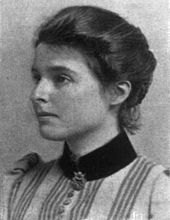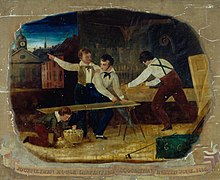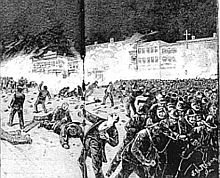https://en.wikipedia.org/wiki/Collective_bargaining
Collective bargaining is a process of negotiation between employers and a group of employees aimed at agreements to regulate working salaries, working conditions, benefits, and other aspects of workers' compensation and rights for workers. The interests of the employees are commonly presented by representatives of a trade union to which the employees belong. The collective agreements reached by these negotiations usually set out wage scales, working hours, training, health and safety, overtime, grievance mechanisms, and rights to participate in workplace or company affairs.
The union may negotiate with a single employer (who is typically representing a company's shareholders) or may negotiate with a group of businesses, depending on the country, to reach an industry-wide agreement. A collective agreement functions as a labour contract between an employer and one or more unions. Collective bargaining consists of the process of negotiation between representatives of a union and employers (generally represented by management, or, in some countries such as Austria, Sweden and the Netherlands, by an employers' organization) in respect of the terms and conditions of employment of employees, such as wages, hours of work, working conditions, grievance procedures, and about the rights and responsibilities of trade unions. The parties often refer to the result of the negotiation as a collective bargaining agreement (CBA) or as a collective employment agreement (CEA).
Collective bargaining is a process of negotiation between employers and a group of employees aimed at agreements to regulate working salaries, working conditions, benefits, and other aspects of workers' compensation and rights for workers. The interests of the employees are commonly presented by representatives of a trade union to which the employees belong. The collective agreements reached by these negotiations usually set out wage scales, working hours, training, health and safety, overtime, grievance mechanisms, and rights to participate in workplace or company affairs.
The union may negotiate with a single employer (who is typically representing a company's shareholders) or may negotiate with a group of businesses, depending on the country, to reach an industry-wide agreement. A collective agreement functions as a labour contract between an employer and one or more unions. Collective bargaining consists of the process of negotiation between representatives of a union and employers (generally represented by management, or, in some countries such as Austria, Sweden and the Netherlands, by an employers' organization) in respect of the terms and conditions of employment of employees, such as wages, hours of work, working conditions, grievance procedures, and about the rights and responsibilities of trade unions. The parties often refer to the result of the negotiation as a collective bargaining agreement (CBA) or as a collective employment agreement (CEA).
History
Beatrice Webb in 1894
The term "collective bargaining" was first used in 1891 by Beatrice Webb, a founder of the field of industrial relations in Britain.
It refers to the sort of collective negotiations and agreements that
had existed since the rise of trade unions during the 18th century.
United States
In the United States, the National Labor Relations Act
of 1935 made it illegal for any employer to deny union rights to an
employee. The issue of unionizing government employees in a public-sector trade union was much more controversial until the 1950s. In 1962 President John F. Kennedy issued an executive order granting federal employees the right to unionize.
An issue of jurisdiction surfaced in National Labor Relations Board v. Catholic Bishop of Chicago (1979) when the Supreme Court held that the National Labor Relations Board (NLRB) could not assert jurisdiction over a church-operated school because such jurisdiction would violate the First Amendment establishment of freedom of religion and the separation of church of state.
International protection
...where free unions and collective bargaining are forbidden, freedom is lost.
Ronald Reagan, Labor Day Speech at Liberty State Park, 1980
The right to collectively bargain is recognized through international human rights conventions. Article 23 of the Universal Declaration of Human Rights identifies the ability to organize trade unions as a fundamental human right. Item 2(a) of the International Labour Organization's Declaration on Fundamental Principles and Rights at Work defines the "freedom of association and the effective recognition of the right to collective bargaining" as an essential right of workers. The Freedom of Association and Protection of the Right to Organise Convention, 1948 (C087) and several other conventions specifically protect collective bargaining through the creation of international labour standards that discourage countries from violating workers' rights to associate and collectively bargain.
In June 2007 the Supreme Court of Canada extensively reviewed the
rationale for regarding collective bargaining as a human right. In the
case of Facilities Subsector Bargaining Association v. British Columbia, the Court made the following observations:
The right to bargain collectively with an employer enhances the human dignity, liberty and autonomy of workers by giving them the opportunity to influence the establishment of workplace rules and thereby gain some control over a major aspect of their lives, namely their work… Collective bargaining is not simply an instrument for pursuing external ends…rather [it] is intrinsically valuable as an experience in self-government… Collective bargaining permits workers to achieve a form of workplace democracy and to ensure the rule of law in the workplace. Workers gain a voice to influence the establishment of rules that control a major aspect of their lives.
Empirical findings
- Union members and other workers covered by collective agreements get, on average, a wage markup over their nonunionized (or uncovered) counterparts. Such a markup is typically 5 to 10 percent in industrial countries.
- Unions tend to equalize the income distribution, especially between skilled and unskilled workers.
- The welfare loss associated with unions is 0.2 to 0.5 percent of GDP, which is similar to monopolies in product markets.
Sweden
In Sweden
the coverage of collective agreements is very high despite the absence
of legal mechanisms to extend agreements to whole industries. In 2018,
83% of all private sector employees were covered by collective
agreements, 100% of public sector employees and in all 90% (referring to
the whole labor market).
This reflects the dominance of self-regulation (regulation by the
labour market parties themselves) over state regulation in Swedish
industrial relations.
United States
In the United States, the National Labor Relations Act
(1935) covers most collective agreements in the private sector. This
act makes it illegal for employers to discriminate, spy on, harass, or
terminate the employment of workers because of their union membership or
to retaliate against them for engaging in organizing campaigns or other
"concerted activities", to form company unions,
or to refuse to engage in collective bargaining with the union that
represents their employees. It is also illegal to require any employee
to join a union as a condition of employment. Unions are also able to secure safe work conditions and equitable pay for their labor.
At a workplace where a majority of workers have voted for union
representation, a committee of employees and union representatives
negotiate a contract with the management regarding wages, hours,
benefits, and other terms and conditions of employment, such as
protection from termination of employment without just cause. Individual
negotiation is prohibited. Once the workers' committee and management
have agreed on a contract, it is then put to a vote of all workers at
the workplace. If approved, the contract is usually in force for a fixed
term of years, and when that term is up, it is then renegotiated
between employees and management. Sometimes there are disputes over the
union contract; this particularly occurs in cases of workers fired
without just cause in a union workplace. These then go to arbitration,
which is similar to an informal court hearing; a neutral arbitrator
then rules whether the termination or other contract breach is extant,
and if it is, orders that it be corrected.
In 24 U.S. states,
employees who are working in a unionized shop may be required to
contribute towards the cost of representation (such as at disciplinary
hearings) if their fellow employees have negotiated a union security
clause in their contract with management. Dues are generally 1–2% of
pay. However, union members and other workers covered by collective
agreements get, on average, a 5-10% wage markup over their nonunionized
(or uncovered) counterparts.
Some states, especially in the south-central and south-eastern regions
of the U.S., have outlawed union security clauses; this can cause
controversy, as it allows some net beneficiaries of the union contract
to avoid paying their portion of the costs of contract negotiation.
Regardless of state, the Supreme Court has held that the Act prevents a
person's union dues from being used without consent to fund political
causes that may be opposed to the individual's personal politics.
Instead, in states where union security clauses are permitted, such
dissenters may elect to pay only the proportion of dues which go
directly toward representation of workers.
The American Federation of Labor was formed in 1886, providing unprecedented bargaining powers for a variety of workers.
The Railway Labor Act (1926) required employers to bargain collectively with unions.
In 1931, the Supreme Court, in the case of Texas & N.O.R. Co. v. Brotherhood of Railway Clerks, upheld the act's prohibition of employer interference in the selection of bargaining representatives. In 1962, President Kennedy signed an executive order giving public-employee unions the right to collectively bargain with federal government agencies.
The Office of Labor-Management Standards, part of the United States Department of Labor,
is required to collect all collective bargaining agreements covering
1,000 or more workers, excluding those involving railroads and airlines. They provide public access to these collections through their website.
OECD
Only one in three OECD
employees have wages which were agreed on through collective
bargaining. The Organisation for Economic Co-operation and Development,
with its 36 members, has become an outspoken proponent for collective
bargaining as a way to ensure that the falling unemployment also leads
to higher wages.










